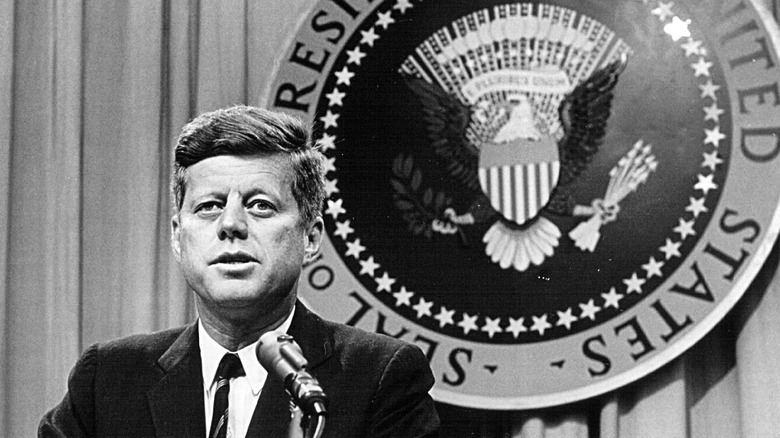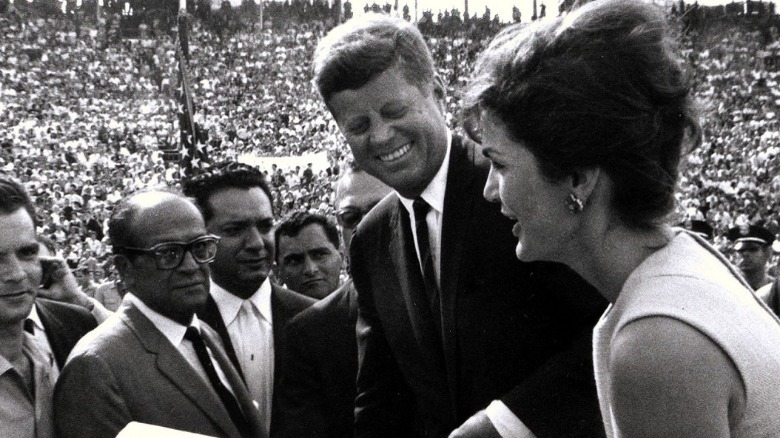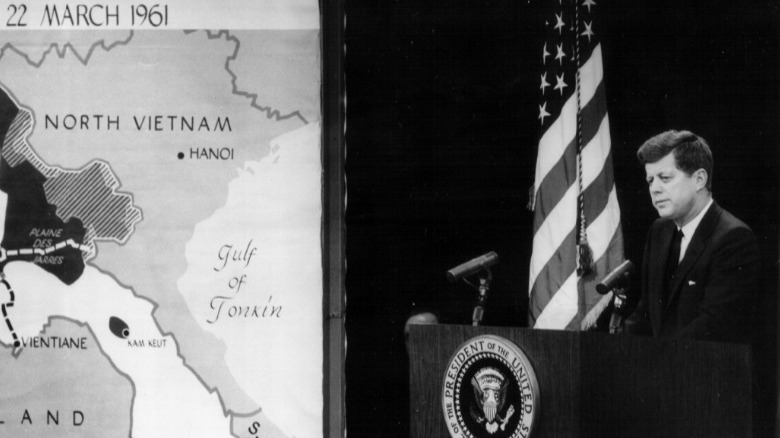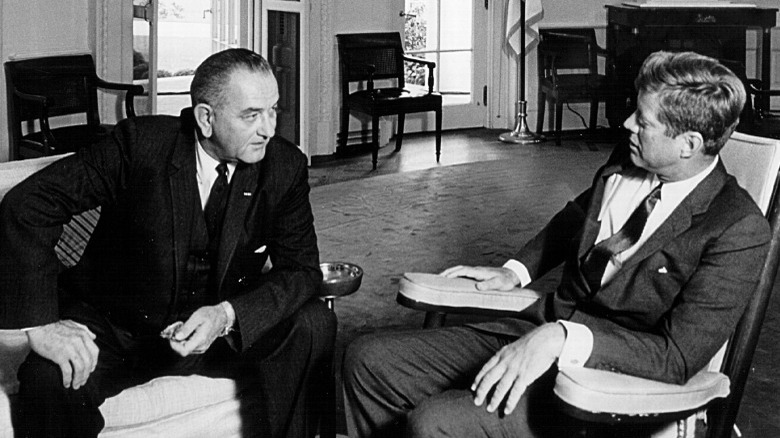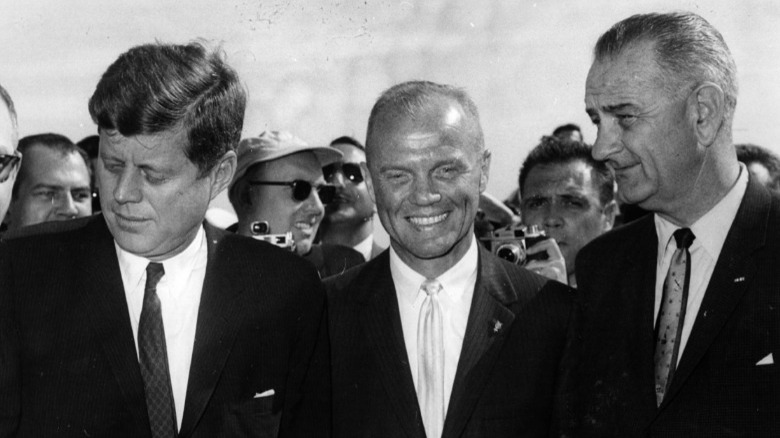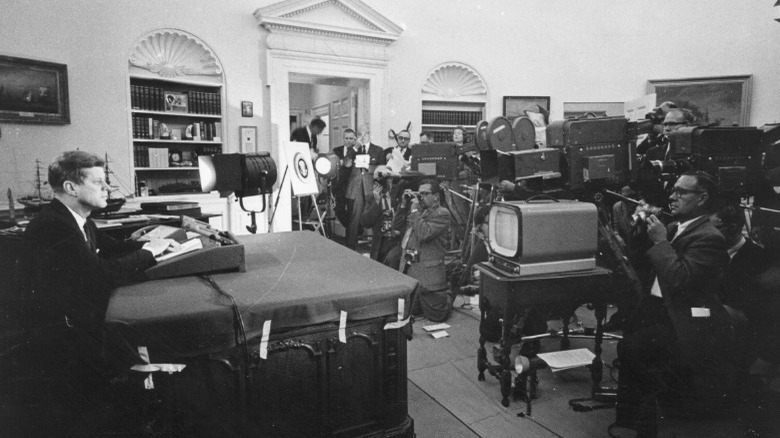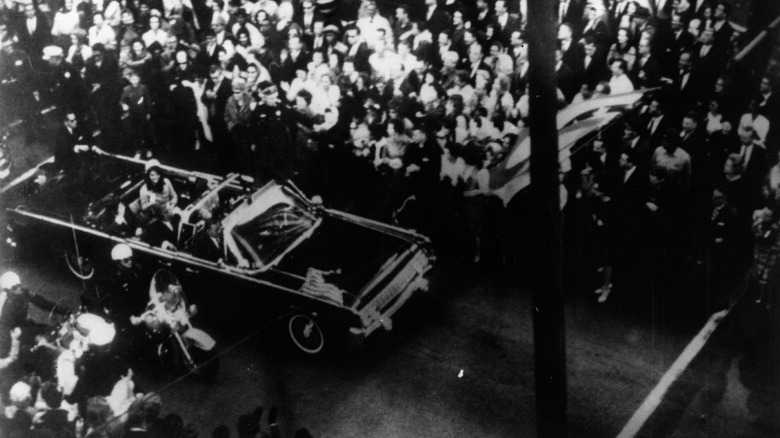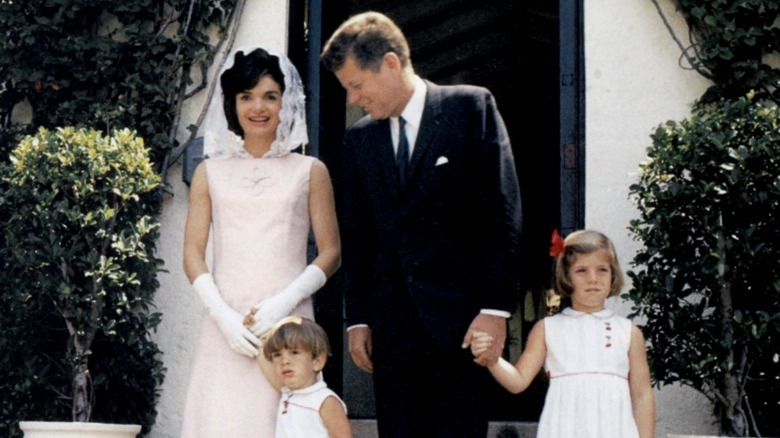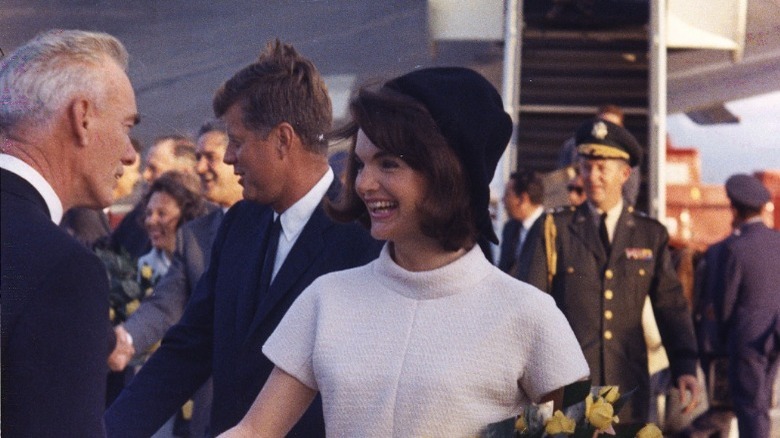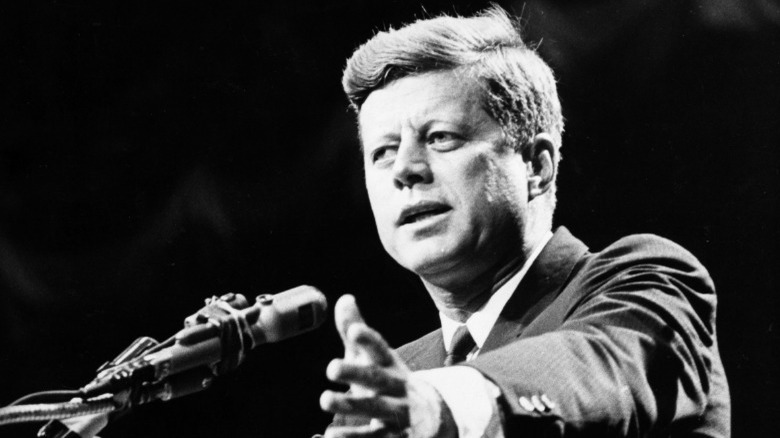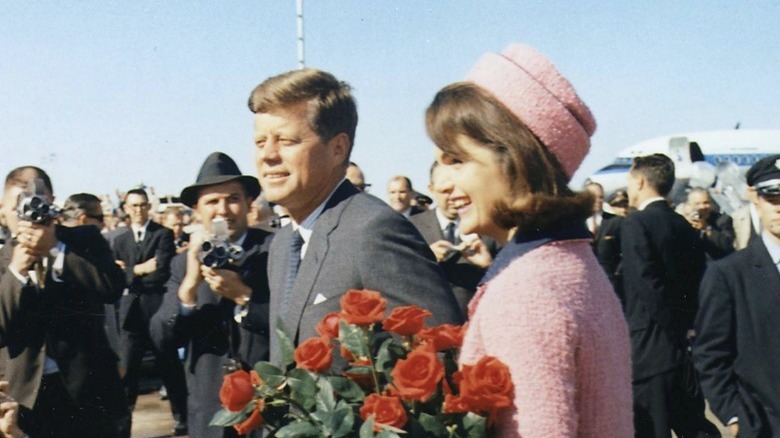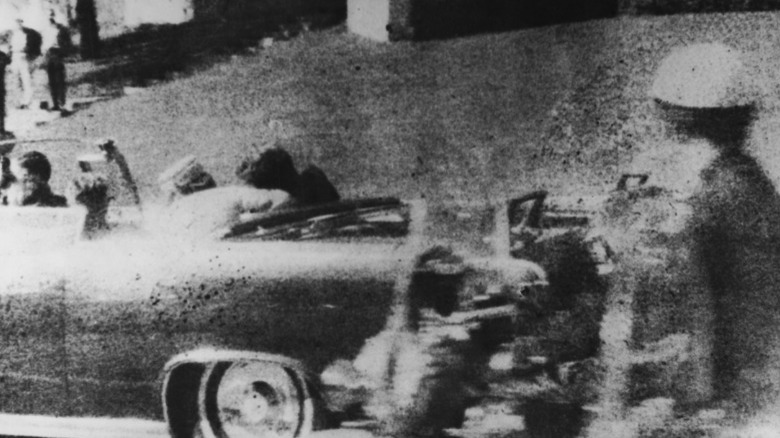What JFK Was Doing On The Final Days Before His Death
On November 22, 1963, two bullets hit President John F. Kennedy as he passed through downtown Dallas in the presidential motorcade. The second bullet struck Kennedy's head, creating a devastating exit wound on the right side of his skull. The president was rushed to Parkland Memorial Hospital, where he was pronounced dead at 1:00 p.m. (via JFK Library).
The assassination of Kennedy is one of the most infamous events in American history. And as with other infamous days, such as 9/11 or the attack on Pearl Harbor, the days preceding the event have taken on chilling and poignant intrigue.
JFK's story has many moments of dramatic irony, from headlines such as "JFK motorcade seems unlikely" to Nellie Connally remarking, "You can't say that Dallas isn't friendly to you today" mere seconds before Kennedy was shot.
Here is a breakdown of what JFK was doing in the final days before his death.
JFK was campaigning for re-election
By November 1, 1963, President John F. Kennedy had been in office for over 1000 days and was thinking ahead to the 1964 election (via The White House). Kennedy had not formally announced his candidacy, but it was clear to most that he would opt for re-eclection (via JFK Library). His most likely opposition would have been Barry Goldwater, a political rival yet personal friend.
Goldwater, who lost in a landslide to Kennedy's successor Lyndon Johnson in 1964, later conceded, "Jack would probably have beaten me by a good margin. I can say that now and even smile about it a bit" (via Shaun Kelly). However, nothing was certain in the fall of 1963.
The 1960 election had been close for Kennedy, who had fought onerously for his party's nomination and then won the popular vote by only 112,000 ballots (via Constitution Center & Britannica). Also, Kennedy's disapproval rating had climbed steadily through 1963, which is likely to have stressed his concerns for the upcoming election (via History in Pieces).
Kennedy addressed these concerns on a meeting on November 12, 1963, stressing the importance of winning Florida and Texas in the next election. The president committed to events in both states, including a five-day, two-city tour of the Lone Star state (via JFK Library).
Kennedy visited Florida
President John F. Kennedy visited Florida before Texas, speaking in Tampa and Miami. Florida had not supported a Democrat since 1948. In the 1960 election, Kennedy lost the state to Richard Nixon, who won by a slim majority of 47,000 votes, gaining 10 electoral college votes (via Tampa Times and National Archives).
Kennedy was expected to address two key issues: an Argentine order that cancelled lucrative American contracts, and to promote the Alliance for Progress, which was an economic initiative between the U.S. and Latin America (via JFK Library).
Kennedy also discussed the Cuban people, whom he encouraged to overthrow their communist government (via Tampa Times). He added that the U.S. would remain steadfast against any communist development in the western hemisphere, a commitment that had landed Kennedy in hot water after the disastrous Bay of Pigs invasion, which occurred in April 1961, just two months into his presidency.
Kennedy spent time at his father's Palm Beach property to prepare his speeches, assembling two Latin American advisers to assist with his speechmaking. These advisors were Ralph Dungan and Richard N. Goodwin, both of whom would serve in Lyndon Johnson's administration.
Kennedy had scheduled a meeting with an Indonesian general
Some of President John F. Kennedy's tapes revealed that he was to meet with General Nasution of Indonesia on November 25, 1963, which was to be the day of his funeral in Washington, DC (via CBS & Miller Center). In one eerie moment recorded on November 19, three days before his death, Kennedy said that the meeting was going to be part of a "tough day."
Indonesia was an important domino in America's "domino theory" policy, which speculated that if Vietnam fell to communist forces, so would other countries in the region, including Cambodia, Laos, Japan, Indonesia and the Philippines (via History).
President Kennedy nurtured a relationship with President Sukarno, who had a "neo-Marxist, crypto-communist ideology," hosting him at the White House in April 1961 (via Britannica & JFK Library). However, Lyndon Johnson's administration would go on to support the Indonesian Army's coup d'état against Sukarno in 1965, which led to the ousting of Sakarno and the deaths of some 500,000 people (via National Security Archive).
JFK was overseeing what would become the Vietnam War
In the last weeks of his life, President John F. Kennedy struggled with the issue of Vietnam. South Vietnam's leader, President Diem, was assassinated on November 2, 1963 (via History), mounting pressure on Kennedy to decide whether to commit greater military forces. Kennedy was recorded as saying, "On the one hand, you get the military saying the war is going better and, on the other hand, you get the political (opinion) with its deterioration is affecting the military" (via CBS).
President Lyndon Johnson is often blamed for the Vietnam War because there were some 548,000 troops in Vietnam when he left office in 1968, with 30,000 of them dead (via Miller Center). However, President Kennedy had a key role in expanding the American presence in the Vietnam.
President Eisenhower had sent just 700 US military personnel to Vietnam during his administration. By the end of 1962, President Kennedy had increased this number to 11,000, which would surge to 16,000 by November 1963 (via JFK Library). This was a marked increase that arguably laid the groundwork for President Johnson's "secret plans for an expansion of U.S. military involvement in Vietnam," which would be fully enabled by the Gulf of Tonkin Incident on August 2, 1964 (via History).
Kennedy considered dropping LBJ as Vice President
According to President John F. Kennedy's secretary, Evelyn Lincoln, the president considered replacing Vice President Lyndon B. Johnson with Governor Terry Sanford of North Carolina, the southern democrat who had supported Kennedy in 1960 (via The Daily Beast).
On November 19, 1963 which Lincoln described as "one of the most pleasant days" during her time at the White House, Kennedy thought aloud as he addressed her, "You know, if I am re-elected in '64... I am going to advocate changing some of the outmoded rules and regulations in Congress, such as the seniority rule. To this I will need as a running mate in sixty-four a man who believes as I do."
Johnson exasperated Kennedy, and JFK did not consider the Vice President fit to assume the presidency. For example, when Kennedy appointed Johnson to the Presidential Commission on Equal Employment Opportunity, members complained that Johnson was an indifferent leader. Kennedy remarked to his brother Bobby, "That man can't run this committee... can you think of anything more deplorable than him trying to run the United States?"
The tension between Kennedy and LBJ has been corroborated by several figures, including Jackie Kennedy, who wrote, "As his term progressed, he grew more and more concerned about what would happen if LBJ ever became president. He was truly frightened at the prospect."
Kennedy toured Cape Canaveral
On November 16, 1963, Kennedy visited Cape Canaveral to inspect NASA's man-on-the-moon project and to direct a submarine-launched Polaris ballistic missile (via Tampa Times). The USS Andrew Jackson fired the 16-ton rocket, which was described as one of the nation's deadliest nuclear weapons.
It was Kennedy's third tour of the NASA site in less than two years. After all, Kennedy had made the "Address at Rice University on the Nation's Space Effort" in September 1962, informally known as the "We Choose to go to the Moon" speech.
In his rousing speech, Kennedy emphasised that "man and his quest for knowledge and progress is determined and cannot be deterred," adding that "we shall send to the moon, 240,000 miles away, a giant rocket more than 300 feet tall... we choose to go the moon in this decade and the other things not because they are easy, but because they are hard."
At first, JFK was too busy for a Dallas motorcade
A report in the Dallas Morning News stated, "JFK motorcade seems unlikely" because of a "tight schedule." It is one of those details of history that's loaded with dramatic irony — a decision on a routine motorcade that could have changed as quickly as the weather altered the course of history.
Many requests were made for the motorcade to pass through Dallas, especially from Democratic members who thought the president should meet the "rank and file party workers," but the president of Forth Worth Chamber of Commerce said the prospects "weren't too bright." Initial suggestions of a motorcade were rejected by Kennedy's aides on the grounds of "insufficient time," which was so tight that they planned to fly the president the 13-minute, 30-mile journey from Forth Worth to Dallas in Air Force One rather than a presidential helicopter.
Kennedy ignored concerns about hostile crowds in Dallas
There were concerns that President John F. Kennedy would be met with hostility in Dallas. JFK was well aware of the contempt that some Dallas residents had for him, telling Jackie Kennedy that they were "heading into nut country" (via The Guardian). "Dallas 1963" author Steven Davis wrote, "The city leaders came together in opposition to Kennedy. Dallas was really the antithesis of what Kennedy represented."
The city had also rallied against the Ambassador to the United Nations, Adlai Stevenson, who was spat on and assaulted during a visit in October 1963 (via Four Days, pg. 7). However, Kennedy brushed concerns aside, especially after the warm receptions he received in San Antonio, Houston, and Fort Worth. In fact, he made even more time to meet and greet bystanders, delaying the Dallas motorcade by some five minutes (via Insider).
The White House confirmed the motorcade route through Dallas on November 19, 1963 (via Warren Commission). The route was detailed in the Dallas Times Herald, which caused the Warren Commission to speculate that killer Lee Harvey Oswald had referenced the paper in preparation for his attack.
Kennedy shared his last breakfast with his children
On the morning of Thursday, November 21, 1963, President John F. Kennedy had breakfast with his children, Caroline and John Jr. Caroline left for school at 9:15 a.m. Shortly afterwards, at 9:55 a.m, Kennedy arrived at his office for the last time, where he met with Charles Darlington and Thomas Estes, U.S. ambassadors to Gabon and the Upper Volta, respectively.
Kennedy then left for the airport with his wife, Jackie, and son. John Jr. was taken into care as the presidential couple left for San Antonio, the first stop of their Texan tour. (via History Central).
Tragically, when reflecting on her father's 100th birthday, Caroline Kennedy said that she "thought about him and missed him every day" (via Boston25 News). Just 5 years old when her father was murdered, she recollected how she would hide under his desk in the Oval Office, as well as sit with him on the Honey Fitz, the wooden yacht that helped define Kennedy's New England charm.
Kennedy began his Texas tour in San Antonio and Houston
After landing in Texas on November 21, 1963, President John F. Kennedy spoke in San Antonio and Houston (via JFK Library). Although there was resistance to his views on civil rights and foreign policy, the crowds in these two cities were consistently warm and cheery. At Brooks Air Force Base in San Antonio, Kennedy said, "We do stand on the edge of a great new era, filled with both crisis and opportunity," adding that it was a time for "pathfinders and pioneers."
In Houston, Kennedy visited at the Rice Hotel, where he had previously stayed in September 1962 after his iconic "We Choose to go to the Moon" speech at Rice University (via History Central). After speaking to the League of United Latin American Citizens and attending a dinner for Representative Albert Thomas, John and Jackie Kennedy flew to Fort Worth, where they had a late night motorcade before staying at the Texas Hotel (via Insider).
JFK's second day in Texas began with a breakfast speech in Fort Worth
On the morning of November 22, 1963, President John F. Kennedy spoke to the local Chamber of Commerce at the Hotel Texas in Fort Worth (via Four Days, pg. 8). He was reportedly in jovial spirits, joking about the popularity of his wife, "Nobody wonders what Lyndon and I wear."
Shortly before that, at 8:45 a.m., he had met with a crowd outside the hotel, giving a small speech. In response to questions about Jackie Kennedy's whereabouts, Kennedy said, "Mrs Kennedy is organising herself, it takes longer... but of course she looks better than we do."
Kennedy also spoke seriously about Fort Worth and its role in defence, invoking its large military and industrial capacity during World War II. After this, at 11:00 a.m., the Kennedys rode to Carswell Air Force Base, where they would make the 13-minute flight to Dallas Love Field on Air Force One (via NBCDFW). At one point during their preparation, JFK quipped to Jackie about the previous night's motorcade, "You know, last night would have been a hell of a night to assassinate a president" (via Insider).
Kennedy landed in Dallas Love Field and began the motorcade to the Trade Mart
President John F. Kennedy landed at Dallas Love Field at 11:37 a.m. and was met with thousands more Texans, who displayed their enthusiasm and affection for the president (via Four Days, pg. 11). Kennedy shook hands in the balmy Texas weather, which had reached 76 degrees, allowing the motorcade to ride as a convertible without its bullet-proof windows to protect the passengers.
The Governor of Texas, John Connally, and his wife, Nellie, joined the Kennedys in the limousine, which began its 11-mile circuit of Dallas en route to the Trade Mart at 11:50 a.m. The motorcade stopped several times so that Kennedy could greet the warm crowds, which delayed the schedule by about five minutes (via Insider).
This was the final leg of Kennedy's Florida and Texas election trip. After the luncheon speech at the Trade Mart, Kennedy was to spend Friday night at Lyndon Johnson's ranch, unwinding amongst the 2,700 acres of Texas pasture (via Texas Monthly & NPS). Then, on Monday November 25, 1963, he planned to be back to work for the "tough day" with the Indonesian general.
Kennedy's motorcade turned onto Elm Street and passed the Texas School Book Depository
At 12:29 p.m., the motorcade joined Houston Street, and then made a sharp left down Elm Street, just past the seven-story Texas School Book Depository (via Insider). After all of the fanfare along Main Street, Nellie Connally turned to the president and said, "You can't say that Dallas isn't friendly to you today," to which President John F. Kennedy replied, "No, you certainly can't" (via Four Days, pg. 14 and Reader's Digest).
At that moment, a gunshot sounded from the Texas School Book Depository and over the motorcade, the bullet striking a nearby pavement. A second shot followed, hitting Kennedy in the back of his neck and exiting through his throat, hitting and seriously injuring Governor Connally in the seat in front (via Warren Commission). A third shot struck the back of Kennedy's head, causing a devastating exit wound on the right side of his skull. Deep in shock, Jackie Kennedy cradled her husband in her lap, asking, "Jack, can you hear me? I love you" (via Reader's Digest).
Kennedy was still alive when the motorcade arrived at Parkland Memorial Hospital, but only just. Dr. Carrico, the first physician to see the president, described his desperate condition, "The president was blue-white or ashen in color; had slow, spasmodic, agonal respiration without any coordination; made no voluntary movements; had his eyes open with the pupils dilated without any reaction to light; evidenced no palpable pulse; and had a few chest sounds which were thought to be heart beats." (via Warren Commission).
With a portion of his brain missing, Dr. Robert McClelland observed Kennedy's injury as "absolutely fatal." At 1:00 p.m., 30 minutes after the shooting, President John F. Kennedy was declared dead, aged just 46.
